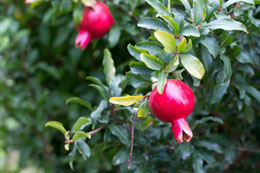The information regarding pomegranate tree pruning and the facts about pomegranate tree planting are provided in the following article. If one wants to understand how to grow a pomegranate tree, reading the following information would prove to be 'fruitful'.

The pomegranate which is a deciduous shrub/small tree reaching the height between 5 - 8 m is native to southwest Asia and is widely cultivated around the world. The practice of pomegranate tree growing is carried out in Azerbaijan, Armenia, Turkey, Iran, peninsular Malaysia, southeast Asia, tropical Africa and the East Indies. The pomegranate tree bears fruits from September to February in the Northern Hemisphere while the period between March and May is the season for the Southern Hemisphere. The pomegranate fruit is highly nutritious and thus, considered good for health.
Pruning of Pomegranate Tree
The practice of pruning is important in pomegranate tree care and it is carried out in the early spring. It is done before the new foliage starts appearing on the tree. Pruning is carried out mainly for the removal of dense outgrowth of shoots. The pomegranate tree pruning is carried out with the help of loppers which useful in cutting the desired shoots easily. The first step in the process of pruning is to identify the right shoots which need to be pruned. The shoots are cut with the help of a lopper and disposed off in a compost site. A semi solid preparation called salve (which has medicinal properties) is applied to the suckers or exposed portion of the shoots which are pruned. It prevents the entry of virus or bacteria through the exposed part of the shoots. The process of pruning is continued till the desired shape is attained. The final step is the provide support to the plant with the help of stakes. The pomegranate wood is soft and therefore, to prevent the tree from blowing away, it is supported with the help of stakes.
How to Grow a Pomegranate Tree
The pruning of pomegranate tree though an important part of growing this, one should also understand the different practices involved in the cultivation process.
Pomegranate Tree Planting: The planting of pomegranate could be carried out with the help of seeds and woody cuttings that are dormant. The other means of pomegranate propagation are grafting, budding and layering. To carry out seed planting of pomegranates, the seeds are first separated from the fleshy tissue which surrounds them. Once the seeds are separated from the tissue, they are planted in shallow beds. The pomegranates can either be grown in hedge rows or as single trees. The distance between two pomegranate trees need not be greater than 12 - 16 feet.
It is important to remove the suckers of the pomegranate tree since, excessive sucker growth causes the pomegranate plant to become a shrub. The fertilizer requirement of the pomegranate plant is relatively less than other fruit plants. It is recommended to use nitrogenous fertilizers if the foliage starts turning yellow or chlorotic. For chlorotic plants an added dose of micronutrients along with nitrogenous fertilizers proves to be beneficial. The pomegranate plant is tolerant/adaptable to different types of soils and is more capable of surviving saline soil conditions than any other plants. However, it doesn't grow properly in poorly drained soils or water logged soils.
The above article discusses information about pomegranate tree pruning and a short account of pomegranate tree care. Thus, one can get a rough idea about how to grow a pomegranate tree with the help of the above information.






 The pomegranate which is a deciduous shrub/small tree reaching the height between 5 - 8 m is native to southwest Asia and is widely cultivated around the world. The practice of pomegranate tree growing is carried out in Azerbaijan, Armenia, Turkey, Iran, peninsular Malaysia, southeast Asia, tropical Africa and the East Indies. The pomegranate tree bears fruits from September to February in the Northern Hemisphere while the period between March and May is the season for the Southern Hemisphere. The pomegranate fruit is highly nutritious and thus, considered good for health.
The pomegranate which is a deciduous shrub/small tree reaching the height between 5 - 8 m is native to southwest Asia and is widely cultivated around the world. The practice of pomegranate tree growing is carried out in Azerbaijan, Armenia, Turkey, Iran, peninsular Malaysia, southeast Asia, tropical Africa and the East Indies. The pomegranate tree bears fruits from September to February in the Northern Hemisphere while the period between March and May is the season for the Southern Hemisphere. The pomegranate fruit is highly nutritious and thus, considered good for health.